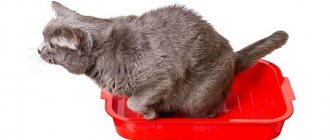Cats are very graceful and flexible animals. Their ability to deftly overcome even very high obstacles is admirable. But sometimes the owner may notice that the cat has a limp and a swollen paw, and there is no trace of grace left. This is a reason to carefully assess your pet’s health status and, if necessary, consult a doctor.
Possible causes and additional symptoms
If your cat's paw is swollen and he cannot step on it, you should try to determine the cause at home. Edema can be localized or general: in the first case, it does not extend beyond a limited area, in the second, the animal’s entire limb swells completely.
cat paws
For your information! Most often we are talking about one paw, but often two or four limbs swell, which is why the animal is not able to move normally.
Joint inflammation
When joints become inflamed as a result of arthrosis or arthritis, the limbs swell locally, which is accompanied by severe pain. A cat may limp on one or more legs if arthritis affects more than one limb. More often, joints become inflamed in older animals whose mobility is limited.
Allergic reaction
If a cat has a tumor on its paw, the cause may be an acute allergic reaction. Most often this occurs due to insect bites; the swelling in this case is very large and is accompanied by pain in the limb. The pet is given antihistamines after consultation with a veterinarian.
Cancer tumor
Breast cancer can also cause your cat to have a very swollen paw pad or entire limb. The tumor can fester or swell; this occurs due to the blockage of the flow of lymph in the vessel and its stagnation.
How is a veterinarian examined?
Note! The swelling will be localized on the side where the cancer began to develop.
Swelling after catheter
It is not uncommon for a cat's paw to swell after a catheter is inserted if the cat is being treated for a medical condition. Staying on a drip for a long time has its side effects and can lead to swelling where the needle is inserted.
Venous insufficiency
Constant swelling of the limbs is a signal of venous insufficiency, from which the animal most likely suffers. Without treatment, this pathology can lead to acute blockage of blood vessels, subsequent necrosis, amputation of the paw and even death. For venous diseases, the cat requires treatment and observation under the supervision of a specialist.
Fungal infection
Mycoses can also cause edema, severe lameness and swollen limbs in cats. Most often they develop due to weakened immunity. If your cat has a swollen paw, you should check the animal for a fungal infection, symptoms of which include peeling and itchy skin, dandruff and an unpleasant odor.
Injury
If your cat's hind legs are swollen, injuries are often to blame. The animal may have a fracture or dislocation, causing swelling. A clear sign is limping on one or both legs, redness at the site of swelling, increased temperature, damaged skin and the presence of wounds.
Lymphadenitis
Lymphadenitis or inflammation of the lymph node also causes swelling, most often in the armpits or forelimbs. The lymph node enlarges and becomes painful when pressed. Lymphadenitis often accompanies various pathologies, for example, infectious diseases.
Hyperparathyroidism
This disease mainly occurs in kittens in the first weeks after birth. Its cause is a disruption in the production of hormones. If your kitten has a swollen front or back leg, it most likely has hyperparathyroidism.
For your information! In addition to swelling, the disease is accompanied by lameness and muscle pain.
Edema and edema are different
Swelling of cat limbs is many-sided and varied, as are the causes that cause them. A cat's paws may swell:
- in a separate relatively small area - with the so-called localized (local or limited, otherwise local) edema;
- over a large area or over the entire surface of the limb - with generalized (or general) edema.
Often the swelling occurs on one paw of the animal (asymmetrical/asymmetrical edema), less often - on two at once (symmetrical edema).
Photo gallery: types of paw edema in cats
Localized swelling occurs in a relatively small, localized area of the cat's paw
Generalized edema covers a significant area of the animal's limb
Symmetrical swelling appears on both legs of the pet at once
Moreover, in most cases, just by the appearance and location of the swollen areas, one can assume what caused their appearance. Moreover, swelling of the paws characteristically affects the behavior of the animal and is often accompanied by additional specific symptoms.
First aid if your paw is swollen
When a cat's paw is swollen and he is limping, you need to know exactly what to do in order to quickly provide first aid to the animal. The pet is examined for wounds and bruises. If you have them, you can treat them at home yourself. In severe cases, it is better to contact a veterinary clinic. Standard care for wounds and minor blisters includes:
- rinsing with chlorhexidine and hydrogen peroxide;
- treating the skin around the injury with iodine or alcohol;
- applying a bandage soaked in levomekol or ichthyol ointment.
The cat lost his voice: reasons and what to do
Since limbs can swell for many reasons, do not put off visiting the veterinarian. It is not so difficult to find a suitable specialist; it is important that the examination is carried out on time and treatment is prescribed as soon as possible.
Cats also get plaster casts.
Note! After prescribing treatment, the owner will need to provide the pet with the necessary care, bandage it, give medications and follow a schedule.
Why is it important to find “your” doctor?
Unfortunately, sometimes the cause of swelling of a cat's paw can be a completely ordinary visit to the veterinarian. The first time I encountered such a situation was when my friend was preparing her Sphynx to move to a distant country. By all indications, the cat was absolutely healthy, but the rules required some kind of special blood test. At the veterinary clinic, blood from the vein was taken for analysis without any problems and a pressure bandage was applied to the injured paw to prevent the formation of a hematoma. Everything was done according to the rules, but they forgot to warn the owner that the bandage needed to be removed in about an hour. And my conscientious friend, deciding that it was better to be safe than sorry, left her paw wrapped until the morning (it was in the evening). And early in the morning it turned out that the long-suffering cat’s limb was twice as thick as it was the day before. Fortunately, nothing irreparable happened: it did not lead to tissue necrosis, the paw remained warm and retained sensitivity. So periodic massage and a loose bandage of alcohol-soaked gauze (recommended by another veterinarian) reduced the swelling by lunchtime. The second case directly affected my pet: during the drip administration of vitamins, a poorly secured catheter moved, and the drug went under the skin (instead of a vein). The paw was swollen, any touch to it caused pain, the baby refused to eat. A repeat visit to the veterinarian and a tight bandage with magnesium sulfate applied for an hour and a half corrected the situation. And this time, fortunately, there were also no serious consequences (in the form of an abscess, for example). As it turns out, such cases happen periodically. What can you do: cats are far from the calmest and most obedient patients. However, whatever you say, the doctor’s qualifications also play an important role. Therefore, do not be lazy to make inquiries and find a truly good specialist for your pet (if you value his health, of course). Believe me: a visit to the veterinary clinic closest to your home is not always the right step.
Video: swelling of a cat's paw after incorrect catheter installation
Swelling of cat limbs is many-sided and varied, as are the causes that cause them. Even if you want, you are unlikely to be able to protect your active and curious pet from all potential dangers, and that’s okay. The main thing is that you are a loving, caring and attentive owner for your cat. And then the swelling of your cat’s paw, which you notice in time, will most likely help solve or prevent serious health problems for your pet.
Cats have always been considered unpretentious and hardy, but even they have weaknesses. A cat's paw is made up of soft and smooth pads, and it is very easy to injure its tissues with sharp objects. And if the limb is swollen, you should be concerned and consult a veterinarian.
Diagnostic methods
Regardless of the cause of the edema, it is always necessary to carry out diagnostics, which are done in an inpatient setting. This should be done by a doctor, after an examination he will be able to make an accurate diagnosis. Diagnostics helps to find out what caused the swelling, especially if it is impossible to identify visible damage and recognize the causes of the symptoms. Primary diagnosis includes a standard external examination of the limb and the animal as a whole.
The cat is limping on its front leg without visible damage
Important! It is necessary to carry out a diagnosis in any case; you should not treat your pet at home on your own without a veterinarian. This is fraught with negative consequences and deterioration of the animal’s condition.
X-ray of paws
After an external examination, blood and other body fluids are tested and, if necessary, a cardiogram is performed to evaluate the functioning of the heart. To assess damage to a limb, your doctor will perform an MRI or X-ray to check for fractures, dislocations, and bruises. If the diagnosis is confirmed, the swollen limb is treated and treatment is prescribed.
Description of the drug Bonharen
The active substance of the drug is hyaluronic acid (in the form of sodium hyaluronate), which is the main element of cartilage tissue and synovial fluid. According to research, with inflammatory changes in the joints, its content decreases, which leads to disruption of the viscosity of the synovial fluid and the strength of chondrocytes. Additional administration of hyaluronic acid for arthritis in animals helps to compensate for its deficiency and reduce the wear and tear of the joint.
The main indications for prescribing Bonharen to cats are:
- acute and chronic arthritis/polyarthritis;
- osteoarthritis;
- arthrosis;
- tendovaginitis;
- bursitis.
The drug is also used for inflammation and injury to the eyeball in animals in order to restore normal metabolism in the organ.
Release form: sterile solution for subcutaneous or intravenous administration. Sold in ampoules of 2 and 6 ml. There are 3 ampoules in the package.
Recommended dosage for cats:
- with a weight of less than 5 kg – 0.1 ml/kg, which corresponds to 1 mg/kg;
- with a weight of more than 5 kg - 0.05 ml/kg, which corresponds to 0.5 mg/kg.
When administered parenterally, the effect of Bonharen is observed after 4 hours, and the total period of activity is 2-3 days. The course of application is from 3 to 7 injections, which must be performed every 5-7 days. The drug can be prescribed to pregnant and lactating cats. There are no contraindications to it. As a side effect, veterinarians note the appearance of a local reaction to the injection, which manifests itself as swelling and disappears after 1-2 days.
How is the treatment carried out?
The pet must be treated according to the system chosen by the specialist, taking into account the diagnosis. A limb can swell for many reasons, so the owner should take care of preliminary diagnosis and do it as soon as possible. If the swollen paw is very inflamed, the problem is most likely an infection. In this case, the animal requires antibiotics or even surgical care.
The dog's muzzle is swollen on one side: causes
Important! You can alleviate his condition before going to the clinic with the help of cold compresses.
If you have an allergy, give an antihistamine tablet; a fungal infection will require urgent use of an antifungal agent. When swelling appears due to venous stagnation, arthritis, kidney disease, heart disease or liver disease, the underlying disease must first be treated. You should not try to treat your pet yourself or give it medications without first consulting a specialist. Edema is a symptom of many serious diseases that require urgent treatment.
Video
What to do in an emergency?
In case of injury or after surgery, the owner should know how to provide first aid to the pet:
- If a cat's hind legs are swollen after anesthesia, and the sore spot is hot when touched, it may be thrombophlebitis. You should lubricate the limb with Troxevasin liniment and take the pet to the veterinary clinic.
- If you have tightened your paw with a clamp, you need to loosen it a little so that blood circulation is restored and the swelling goes away.
- In case of a bruise, you should apply a cold compress, alternating for 15 minutes, which will help relieve pain and prevent the development of swelling.
The sore limb of the fluffy needs to be secured with a bandage.
For fractures and dislocations, the algorithm for assistance is as follows:
- Provide rest to the limbs and limit the cat’s mobility.
- Apply a cold compress.
- Secure the paw with planks, making a soft spacer between the skin and the clamp.
- Apply a bandage, not too tight.
Preventive measures for skin disease in cats
- Get the vaccine against fungal diseases (Vakderm) on time.
- Don't let your cat go outside. A pet that walks without control may well come into contact with sick animals.
- Support your pet's immunity. For prevention, give medications to strengthen the liver (Hepatovet) and immunity (Immunofan).
- Give the animal only high-quality food, do not overfeed.
- Consult a doctor at the first symptoms of cat skin diseases and begin treatment immediately.











